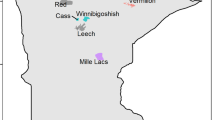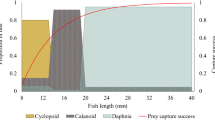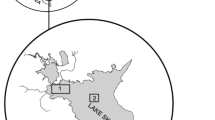Abstract
Bythotrephes longimanus, an invasive zooplankter from Eurasia, has caused severe declines in native zooplankton communities in Rainy and Kabetogama lakes in northern Minnesota. Both lakes have experienced a 40–60% decrease in peak summer zooplankton biomass following B. longimanus establishment around 2006–2007. In these lakes, yellow perch (Perca flavescens) are a key fishery species, and young-of-the-year (YOY) yellow perch are mainly planktivorous during their first summer. This led to concern that their growth could be detrimentally affected by the depletion of zooplankton forage. We used seining data to compare growth rates of YOY yellow perch before (2001–2005) and after (2008–2012) B. longimanus establishment in Rainy and Kabetogama lakes. Nearby Lake Vermilion, assumed to have been unaffected by B. longimanus during this time period, was used as a reference for natural variation in YOY growth in the region. YOY yellow perch length was modeled as a linear function of cumulative growing degree days (GDD) throughout the summer, and the slope of the relationship was compared between pre- and post-B. longimanus time periods for the three study lakes. The two lakes with B. longimanus showed similar decreases in YOY yellow perch growth rate relative to GDD, whereas Lake Vermilion showed no evidence of a decline in growth rates during this period. The reduction in growth rates resulted in an approximate 10% decrease in mean length of YOY yellow perch at the end of the summer after B. longimanus establishment, which could lead to further effects of this invasive zooplankter at higher trophic levels.


Similar content being viewed by others
References
Barbiero RP, Tuchman ML (2004) Changes in the crustacean communities of Lakes Michigan, Huron, and Erie following the invasion of the predatory cladoceran Bythotrephes longimanus. Can J Fish Aquat Sci 61:2111–2125. doi:10.1139/f04-149
Barnhisel D (1991) Zooplankton spine induces aversion in small fish predators. Oecologia 88:444–450. doi:10.1007/BF00317591
Barnhisel D, Harvey H (1995) Size-specific fish avoidance of the spined crustacean bythotrephes—field support for laboratory predictions. Can J Fish Aquat Sci 52:768–775
Bates D, Maechler M, Bolker B, Walker S (2015) lme4: linear mixed-effects models using Eigen and S4
Boudreau SA, Yan ND (2003) The differing crustacean zooplankton communities of Canadian Shield lakes with and without the nonindigenous zooplanktivore Bythotrephes longimanus. Can J Fish Aquat Sci 60:1307–1313. doi:10.1139/F03-111
Carpenter SR, Kitchell JF, Hodgson JR (1985) Cascading trophic interactions and lake productivity. Bioscience 35:634–639. doi:10.2307/1309989
Chezik KA, Lester NP, Venturelli PA, Tierney K (2014) Fish growth and degree-days I: selecting a base temperature for a within-population study. Can J Fish Aquat Sci 71:47–55. doi:10.1139/cjfas-2013-0295
Christensen VG, Maki RP (2015) Trophic state in Voyageurs National Park lakes before and after implementation of a revised water-level management plan. JAWRA J Am Water Resour Assoc 51:99–111. doi:10.1111/jawr.12234
Core Team R (2014) R: a language and environment for statistical computing. R Foundation for Statistical Computing, Vienna
Cullis K, Johnson G (1988) 1st evidence of the cladoceran bythotrephes-cederstroemi schoedler in lake-superior. J Gt Lakes Res 14:524–525
Ellis BK, Stanford JA, Goodman D et al (2011) Long-term effects of a trophic cascade in a large lake ecosystem. Proc Natl Acad Sci 108:1070–1075. doi:10.1073/pnas.1013006108
Foster SE, Sprules WG (2009) Effects of the Bythotrephes invasion on native predatory invertebrates. Limnol Oceanogr 54:757–769. doi:10.4319/lo.2009.54.3.0757
Froese R (2006) Cube law, condition factor and weight–length relationships: history, meta-analysis and recommendations. J Appl Ichthyol 22:241–253. doi:10.1111/j.1439-0426.2006.00805.x
Hoffman JC, Smith ME, Lehman JT (2001) Perch or plankton: top-down control of Daphnia by yellow perch (Perca flavescens) or Bythotrephes cederstroemi in an inland lake? Freshw Biol 46:759–775. doi:10.1046/j.1365-2427.2001.00716.x
Hooff RC, Bollens SM (2004) Functional response and potential predatory impact of Tortanus dextrilobatus, a carnivorous copepod recently introduced to the San Francisco Estuary. Mar Ecol Prog Ser 277:167–179. doi:10.3354/meps277167
International Joint Commission (2000) Supplementary order to the order prescribing method of regulating the levels of Bouindary Waters
Jarnagin ST, Kerfoot WC, Swan BK (2004) Zooplankton life cycles: direct documentation of pelagic births and deaths relative to diapausing egg production. Limnol Oceanogr 49:1317–1332
Johnson T, Evans D (1991) Behavior, energetics, and associated mortality of young-of-the-year white perch (morone-Americana) and yellow perch (Perca-flavescens) under simulated winter conditions. Can J Fish Aquat Sci 48:672–680
Kallemeyn LW, Holmberg KL, Perry JA, Odde BY (2003) Aquatic synthesis for Voyageurs National Park. U.S. Geological Survey
Kerfoot WC, Yousef F, Hobmeier MM et al (2011) Temperature, recreational fishing and diapause egg connections: dispersal of spiny water fleas (Bythotrephes longimanus). Biol Invasions 13:2513–2531. doi:10.1007/s10530-011-0078-8
Kerfoot WC, Hobmeier MM, Yousef F et al (2016) A plague of waterfleas (Bythotrephes): impacts on microcrustacean community structure, seasonal biomass, and secondary production in a large inland-lake complex. Biol Invasions 18:1121–1145
Ketelaars HAM, Lambregts-van de Clundert FE, Carpentier CJ et al (1999) Ecological effects of the mass occurrence of the Ponto-Caspian invader, Hemimysis anomala GO Sars, 1907 (Crustacea: Mysidacea), in a freshwater storage reservoir in the Netherlands, with notes on its autecology and new records. Hydrobiologia 394:233–248. doi:10.1023/A:1003619631920
Kutner M, Nachtsheim C, Neter J, Li W (2004) Applied linear statistical models, 5th edn. McGraw-Hill/Irwin, Boston
LeDuc JF (2012) Predator-prey: Interactions between the spiny waterflea (Bythotrephes longimanus) and pumpkinseed sunfish (Lepomis gibbosus). Master’s thesis, Michigan Technological University
Lehman JT (1988) Algal biomass unaltered by food-web changes in Lake Michigan. Nature 332:537–538. doi:10.1038/332537a0
Lehman J, Caceres C (1993) Food-web responses to species invasion by a predatory invertebrate—bythotrephes in Lake-Michigan. Limnol Oceanogr 38:879–891
Mills EL, Green DM, Schiavone A Jr (1987) Use of zooplankton size to assess the community structure of fish populations in freshwater lakes. N Am J Fish Manag 7:369–378. doi:10.1577/1548-8659(1987)7<369:UOZSTA>2.0.CO;2
Mills EL, O’Gorman R, DeGisi J et al (1992) Food of the alewife (Alosa pseudoharengus) in Lake Ontario before and after the establishment of Bythotrephes cederstroemi. Can J Fish Aquat Sci 49:20092019. doi:10.1139/f92-224
Neuheimer AB, Taggart CT (2007) The growing degree-day and fish size-at-age: the overlooked metric. Can J Fish Aquat Sci 64:375–385. doi:10.1139/F07-003
Parker-Stetter S, Witzel LD, Rudstam LG et al (2005) Energetic consequences of diet shifts in Lake Erie rainbow smelt (Osmerus mordax). Can J Fish Aquat Sci 62:145–152. doi:10.1139/f04-175
Post JR, Evans DO (1989) Size-dependent overwinter mortality of young-of-the-year yellow perch (Perca flavescens): laboratory, in situ enclosure, and field experiments. Can J Fish Aquat Sci 46:1958–1968
Post J, Mcqueen D (1988) Ontogenetic changes in the distribution of larval and Juvenile yellow perch (Perca-flavescens)—a response to prey or predators. Can J Fish Aquat Sci 45:1820–1826. doi:10.1139/f88-214
Post JR, Johannes MRS, McQueen DJ (1997) Evidence of density-dependent cohort splitting in age-0 yellow perch (Perca flavescens): potential behavioural mechanisms and population-level consequences. Can J Fish Aquat Sci 54:867–875. doi:10.1139/cjfas-54-4-867
Pothoven SA, Höök TO (2014) Predatory demands of Bythotrephes and Leptodora in Saginaw Bay, Lake Huron. J Gt Lakes Res 40:106–112. doi:10.1016/j.jglr.2013.07.005
Raftery AE (1995) Bayesian model selection in social research. Sociol Methodol 25:111–163
Roswell CR, Pothoven SA, Höök TO (2014) Patterns of age-0 yellow perch growth, diets, and mortality in Saginaw Bay, Lake Huron. J Gt Lakes Res 40:123–132. doi:10.1016/j.jglr.2014.01.008
Schulz KL, Yurista PM (1998) Implications of an invertebrate predator’s (Bythotrephes cederstroemi) atypical effects on a pelagic zooplankton community. Hydrobiologia 380:179–193. doi:10.1023/A:1003484813672
Schwarz G (1978) Estimating the dimension of a model. Ann Stat 6:461–464
Smith LL Jr, Butler RL, Krefting LW (1952) Movements of marked walleyes, Stizostedion vitreum vitreum (Mitchill), in the fishery of the Red Lakes, Minnesota. Trans Am Fish Soc 81:179–196. doi:10.1577/1548-8659(1951)81[179:MOMWSV]2.0.CO;2
Strecker AL, Arnott SE (2005) Impact of Bythotrephes invasion on zooplankton communities in acid-damaged and recovered lakes on the Boreal Shield. Can J Fish Aquat Sci 62:2450–2462. doi:10.1139/f05-152
Strecker AL, Arnott SE, Yan ND, Girard R (2006) Variation in the response of crustacean zooplankton species richness and composition to the invasive predator Bythotrephes longimanus. Can J Fish Aquat Sci 63:2126–2136. doi:10.1139/F06-105
Strecker AL, Beisner BE, Arnott SE et al (2011) Direct and indirect effects of an invasive planktonic predator on pelagic food webs. Limnol Oceanogr 56:179–192. doi:10.4319/lo.2011.56.1.0179
Taper ML (2004) Model identification from many candidates. In: Taper ML, Lele SR (eds) Nature of scientific evidence; statitstical, philosophical, and empirical considerations. Chicago
Walsh JR, Carpenter SR, Zanden MJV (2016) Invasive species triggers a massive loss of ecosystem services through a trophic cascade. Proc Natl Acad Sci 113:4081–4085. doi:10.1073/pnas.1600366113
Walters CJ, Martell SJD (2004) Fisheries ecology and management. Princeton University Press, Princeton
Whiteside M, Swindoll C, Doolittle W (1985) Factors affecting the early life-history of yellow perch, Perca-flavescens. Environ Biol Fish 12:47–56. doi:10.1007/BF00007709
Winder M, Jassby AD (2011) Shifts in zooplankton community structure: implications for food web processes in the upper San Francisco Estuary. Estuar Coasts 34:675–690. doi:10.1007/s12237-010-9342-x
Wingate PJ, Schupp DH (1984) Large Lake sampling guide. Minnesota Department of Natural Resources
Acknowledgements
Thank you to numerous MN Department of Natural Resources fisheries personnel for their work in collecting the many years of yellow perch length data necessary for these analyses, and special thanks to K. Peterson, B. Vondra, D. Williams, and M. Hennen for their local knowledge and work in managing the data. Authors would also like to thank M. Treml, J. Giudice and V. St-Louis in addition to three anonymous reviewers for their comments on earlier drafts.
Author information
Authors and Affiliations
Corresponding author
Rights and permissions
About this article
Cite this article
Staples, D.F., Maki, R.P., Hirsch, J.K. et al. Decrease in young-of-the-year yellow perch growth rates following Bythotrephes longimanus invasion. Biol Invasions 19, 2197–2205 (2017). https://doi.org/10.1007/s10530-017-1431-3
Received:
Accepted:
Published:
Issue Date:
DOI: https://doi.org/10.1007/s10530-017-1431-3




